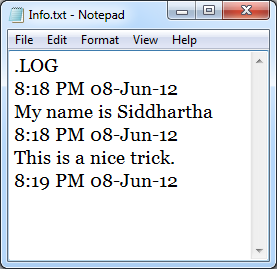(1) Maintain a personal diary with notepad or create a log with notepad
 You can now maintain your personal diary with notepad. I will tell you a really beautiful trick which will save the current system time when you close it. This is really a hidden trick. Very few persons know this. Do as per the instruction.
You can now maintain your personal diary with notepad. I will tell you a really beautiful trick which will save the current system time when you close it. This is really a hidden trick. Very few persons know this. Do as per the instruction.I. Open a notepad and write .LOG in capital letter and save it in any name.
II. Now the next time when you will open it you will see the time and date information has been automatically saved in to the file.
III. This will be helpful when you need to track the date and time information. No need to save the date and time manually.
(2) Easily translate a website into your own language
Go to Google translator and type the website URL you want to translate in the left side text area. Then choose the language according your need. Google will create an link to the website in the right side text area. Click on it, you will see that the entire website has been converted to your language.

(3) It is not mandatory to type the URL in browser’s address bar
You can also open Google by typing the URL in your windows explorer instead of Internet Explorer. Open your My Computer and type your URL in the address bar, press enter and surprisingly you will see the website will open in internet explorer. This is not so much amazing but still a hidden trick which we did not know.

(4) See your entire directory structure in command prompt
Open your command prompt and type tree , then press enter and see what happens. Your entire directory structure will be displayed in a beautiful tree view.
(5) Save your command prompt output in a text file
If you feel bore to read a lengthy output in command prompt then here is very good trick by which you can save the output of command prompt in a text file.
- Enter your command, then provide one greater than symbol and then write the path of the text file where you want to save the output.
Example: ipconfig > d:saveData.txt - If you want your output to be appended in an existing file then provide the greater than symbol 2 times.Example: systeminfo >> d:saveData.txt

(6) How to view your detail system information
You can see your detail system information including Hardware information, Different components, Display, Drivers, Ports, Storage, USB, Printing, Software environment, Network, Sound device, Modem, CD-ROM and many more. Just type System Information in start menu and click on the search result. You will get the detail information about your PC.
You may also like to see

I like this content and i mean this is more essential for the educators. They found more suggestion in here those are more helpful for them to know about technology.
Computer education is now more familiar and this is also so more interesting. Today’s young generation also more eager to know about this technology. So i think this is more effective education for us.